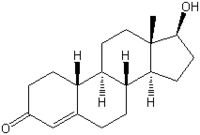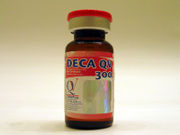Durabolin
Nandrolone is an anabolic steroid occurring naturally in the human body, albeit in small quantities. Nandrolone is most commonly sold commercially as its decanoate ester (Deca-Durabolin) and less commonly as a phenylpropionate ester (Durabolin). Nandrolone use is indirectly detectable in urine tests by testing for the presence of 19-norandrosterone, a metabolism product of this molecule. The International Olympic Committee has set a limit of 2 ng per ml of urine as the upper limit, beyond which an athlete is suspected of doping. more...
Urine analysis as a method of detecting nandrolone abuse has recently become somewhat controversial, following studies by the University of Aberdeen showing that the metabolite product can also show up in urine in quantities above the upper limit from a combination of high-protein diets utilising the legal nutritional supplement creatine and hard cardiovascular exercise. The reason for this unexpected result has not been determined. Another possible (though unlikely) reason for a false positive result is the consumption of beef from cattle treated with steroids including nandrolone (used in overturning the verdict against the bobsleigh racer, Lenny Paul). A final possible cause of incorrect urine test results is the prescence of metabolites from other anabolic steroids. However, as all such substances are also banned, this source is somewhat insignificant when interpreting the results of such a test. As a result of the numerous overturned verdicts, the testing procedure was reviewed by UK Sport in 2000.
Nandrolone binds to the androgen receptor to a greater degree than testosterone, but due to its inability to act on the muscle in ways unmediated by the receptor, has less overall effect on muscle growth. The drug is also unusual in that unlike most anabolic steroids, it is not broken down into the more reactive DHT by the enzyme 5α-reductase, but rather into a less effective product. As such, some of the negative effects associated with most such drugs are somewhat mitigated.
The positive effects of the drug include muscle growth, appetite stimulation and increased red blood cell production and bone density. Clinical studies have shown it to be effective in treating anaemia, osteoporosis and some forms of neoplasia including breast cancer, and also acts as a progestin-based contraceptive. For these reasons, nandrolone received FDA approval in 1983, and while sale is now restricted by the Controlled Substances Act, it remains available by prescription in most countries. In addition to legal production, Nandrolone is also extensively produced and used illegally by athletes and bodybuilders seeking an edge in professional competition.
Because nandrolone is not broken down into DHT, the deleterious effects common to most anabolic steroids on the scalp, skin, and prostate are lessened to a degree. The lack of alkylation on the 17α-carbon drastically reduces the drug's liver toxicity. Estrogenic effects resulting from reaction with aromatase are also mitigated as a result of the drug being a progestin, but effects such as gynaecomastia and reduced libido still occur in larger doses. Other side-effects can include erectile dysfunction and cardiovascular damage, as well as several ailments resulting from the drug's effect of lowering levels of luteinizing hormone through negative feedback.
Read more at Wikipedia.org



